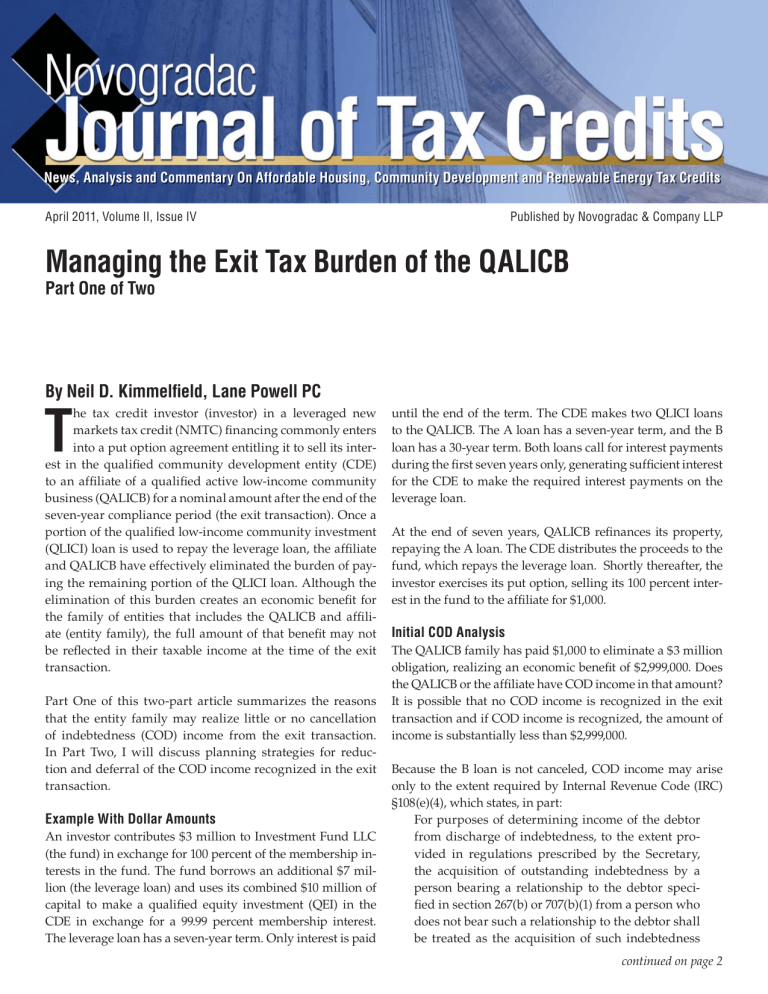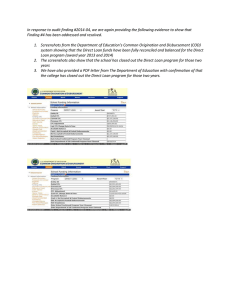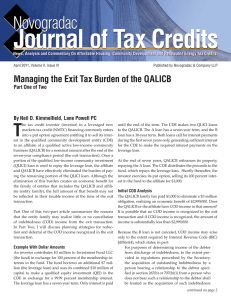
News, Analysis and Commentary On Affordable Housing, Community Development and Renewable Energy Tax Credits
April 2011, Volume II, Issue IV
Published by Novogradac & Company LLP
Managing the Exit Tax Burden of the QALICB
Part One of Two
By Neil D. Kimmelfield, Lane Powell PC
T
he tax credit investor (investor) in a leveraged new
markets tax credit (NMTC) financing commonly enters
into a put option agreement entitling it to sell its interest in the qualified community development entity (CDE)
to an affiliate of a qualified active low-income community
business (QALICB) for a nominal amount after the end of the
seven-year compliance period (the exit transaction). Once a
portion of the qualified low-income community investment
(QLICI) loan is used to repay the leverage loan, the affiliate
and QALICB have effectively eliminated the burden of paying the remaining portion of the QLICI loan. Although the
elimination of this burden creates an economic benefit for
the family of entities that includes the QALICB and affiliate (entity family), the full amount of that benefit may not
be reflected in their taxable income at the time of the exit
transaction.
Part One of this two-part article summarizes the reasons
that the entity family may realize little or no cancellation
of indebtedness (COD) income from the exit transaction.
In Part Two, I will discuss planning strategies for reduction and deferral of the COD income recognized in the exit
transaction.
Example With Dollar Amounts
An investor contributes $3 million to Investment Fund LLC
(the fund) in exchange for 100 percent of the membership interests in the fund. The fund borrows an additional $7 million (the leverage loan) and uses its combined $10 million of
capital to make a qualified equity investment (QEI) in the
CDE in exchange for a 99.99 percent membership interest.
The leverage loan has a seven-year term. Only interest is paid
until the end of the term. The CDE makes two QLICI loans
to the QALICB. The A loan has a seven-year term, and the B
loan has a 30-year term. Both loans call for interest payments
during the first seven years only, generating sufficient interest
for the CDE to make the required interest payments on the
leverage loan.
At the end of seven years, QALICB refinances its property,
repaying the A loan. The CDE distributes the proceeds to the
fund, which repays the leverage loan. Shortly thereafter, the
investor exercises its put option, selling its 100 percent interest in the fund to the affiliate for $1,000.
Initial COD Analysis
The QALICB family has paid $1,000 to eliminate a $3 million
obligation, realizing an economic benefit of $2,999,000. Does
the QALICB or the affiliate have COD income in that amount?
It is possible that no COD income is recognized in the exit
transaction and if COD income is recognized, the amount of
income is substantially less than $2,999,000.
Because the B loan is not canceled, COD income may arise
only to the extent required by Internal Revenue Code (IRC)
§108(e)(4), which states, in part:
For purposes of determining income of the debtor
from discharge of indebtedness, to the extent provided in regulations prescribed by the Secretary,
the acquisition of outstanding indebtedness by a
person bearing a relationship to the debtor specified in section 267(b) or 707(b)(1) from a person who
does not bear such a relationship to the debtor shall
be treated as the acquisition of such indebtedness
continued on page 2
NOVOGRADAC JOURNAL OF TAX CREDITS
continued from page 1
by the debtor.
Novogradac Journal of Tax Credits
Editorial Board
PUBLISHER
IRC §§267(b) and 707(b)(1) describe a wide array of relationships.
Let’s assume that the affiliate and the QALICB are related. If the
exit transaction causes the QALICB to be treated as if it had acquired the B loan for the amount paid by the affiliate, the QALICB
will recognize $2,999,000 of COD income under Treas. Reg. §1.61-12.
However, IRC §108(e)(4) requires treatment only “to the extent provided in regulations.” What do the regulations say?
Treasury Regulation §1.108-2(a) provides that COD income may
arise by reason of a related-party acquisition of indebtedness if either the indebtedness is acquired directly by the related party (a
direct acquisition), or the holder of the indebtedness becomes related to the debtor in an “indirect acquisition.” Assuming the CDE
is respected as a separate entity for tax purposes, the exit transaction is not a “direct acquisition.” Let us consider whether it is an
“indirect acquisition.”
Michael J. Novogradac, CPA
MANAGING EDITOR
Alex Ruiz
EDITOR
Jane Bowar Zastrow
TECHNICAL EDITORS
Robert S. Thesman, CPA
James R. Kroger, CPA
Owen P. Gray, CPA
Thomas Boccia, CPA
Daniel J. Smith, CPA
ASSIGNMENT EDITOR
Jennifer Dockery
STAFF WRITER
Jennifer Hill
CONTRIBUTING WRITERS
Under Treas. Reg. §1.108-2(c)(1), a transaction in which the debtor
and the holder of the debt become related is an indirect acquisition only if “the holder acquired the indebtedness in anticipation
of becoming related to the debtor.” It is not clear that the CDE “acquired” the B loan when it loaned $3 million to the QALICB. The
CDE originated the B loan; before the origination, there was no loan
to acquire.
www.novoco.comApril 2011
2
Similarly, it is not clear that the CDE made the B loan “in anticipation of” the exit transaction. When the CDE made the B loan, the
loan was an economically advantageous investment whether or not
the investor ultimately exercised the put option. There is no direct
authority on either of the foregoing points. In sum, it is possible
that the exit transaction does not give rise to an “indirect acquisition” within the meaning of Treas. Reg. §108(e)(4), and it is possible
that the IRS will not argue that the exit transaction causes the QALICB to recognize COD.
Nonetheless, because the B loan constitutes more than 25 percent
of the CDE’s gross assets on the date of the exit transaction, the QALICB must report COD income as though an indirect acquisition
occurred, unless the QALICB attaches a statement to its tax return
setting forth certain facts about the B loan and describing facts and
circumstances supporting the QALICB’s position that an indirect
acquisition did not occur. (See Treas. Reg. § 1.108-2(c)(4).) Thus, it
will not be possible for the QALICB to fly safely under the radar.
Warning: If, concurrently with the exit transaction, the affiliate acquires the 0.01 percent membership interest in the CDE that is not
held by the fund, and the CDE is an LLC treated as a partnership
for tax purposes, the CDE will become a disregarded entity, and
the affiliate may be treated as acquiring the CDE’s assets. (See Rev.
continued on page 3
Ashley Ashleman
Kelly L. Beigle
Brad Elphick, CPA
Glenn Graff
Owen P. Gray, CPA
Don Holm
Jon Kelly
Neil D. Kimmelfield
Peter Lawrence
Forrest Milder
Charles A. Rhuda III, CPA
Gerald Salzman
Shel Schreiberg
Daniel J. Smith, CPA
Amanda Talbot
John M. Tess
PRODUCTION
Jesse Barredo
James Matuszak
Novogradac Journal of Tax Credits
Information
Address all correspondence and
editorial submissions to:
Alex Ruiz/ 415.356.8088
Address inquiries regarding
advertising opportunities to:
Emil Bagalso / 415.356.8037
Editorial material in this publication is for informational
purposes only and should not be construed otherwise.
Advice and interpretation regarding the low-income
housing tax credit or any other material covered in this
publication can only be obtained from your tax advisor.
© Novogradac & Company LLP
2011 All rights reserved.
ISSN 2152-646X
Reproduction of this publication in whole or in part in any
form without written permission from the publisher is
prohibited by law.
LOW-INCOME HOUSING TAX CREDITS
Bud Clarke
BOSTON FINANCIAL INVESTMENT MANAGEMENT
Jana Cohen Barbe
SNR DENTON
Tom Dixon
continued from page 2
Rul. 99-6, 1999-1 C.B. 432, Situation 2.) In that case, the affiliate will
be treated as acquiring the B loan in a “direct acquisition,” and the
arguments for not treating the exit transaction as an “indirect acquisition” will be irrelevant.
BOSTON CAPITAL
Valerie White
STANDARD & POOR’S CORPORATION
Rick Edson
HOUSING CAPITAL ADVISORS INC.
Richard Gerwitz
CITI COMMUNITY CAPITAL
Rochelle Lento
Let’s assume that the exit transaction is treated as an “indirect acquisition” and the QALICB is therefore treated as if it had acquired
the B loan. How much COD income does the QALICB recognize?
DYKEMA GOSSETT PLLC
John Lisella
U.S. BANCORP COMMUNITY DEV. CORP.
Phillip Melton
GRANDBRIDGE REAL ESTATE CAPITAL
Thomas Morton
PILLSBURY WINTHROP SHAW PITTMAN LLP
Stephen Ryan
COX, CASTLE & NICHOLSON LLP
Arnold Schuster
SNR DENTON
Rob Wasserman
U.S. BANCORP COMMUNITY DEV. CORP.
PROPERTY COMPLIANCE
Rose Guerrero
CALIFORNIA TAX CREDIT ALLOCATION COMMITTEE
Sharon Jackman
SIG SERVICES LLC
Michael Kotin
KAY KAY REALTY
Michael Snowdon
MCA HOUSING PARTNERS
Gianna Solari
SOLARI ENTERPRISES
Ruth Theobald Probst
Kimberly Taylor
THEOPRO COMPLIANCE & CONSULT. INC.
HOUSING DEVELOPMENT CENTER
HOUSING AND URBAN DEVELOPMENT
Sheldon Schreiberg
Monica Sussman
PEPPER HAMILTON LLP
NIXON PEABODY LLP
COMMUNITY REINVESTMENT FUND
Bruce Bonjour
PERKINS COIE LLC
Neil Kimmelfield
LANE POWELL
Marc Hirshman
U.S. BANCORP COMMUNITY DEV. CORP.
Scott Lindquist
SNR DENTON
Ruth Sparrow
A thorough examination of the determination of the fair market
value of the B loan is beyond the scope of this article. Suffice it to say
that if the B loan has a below-market interest rate and a long term,
the fair market value of the loan will be less than its face amount,
but it still should be substantially greater than the $1,000 put price.
Deferral Only
NEW MARKETS TAX CREDITS
Frank Altman
Treas. Reg. §1.108-2(f)(2) provides that if the holder did not “acquire
the indebtedness by purchase” during the six-month period ending
on the “acquisition date,” the amount of COD income is “measured
by reference to the fair market value of the indebtedness on the
acquisition date.” The “acquisition date” is the date on which the
holder and the debtor become related, which is the date on which
the exit transaction occurs. Since the CDE did not acquire the B
loan by purchase during the six-month period ending on that date,
the amount of COD income is the difference between the adjusted
issue price of the B loan ($3 million) and the fair market value of
the B loan on the date of the exit transaction. (See Treas. Reg. §1.6112(c)(2)(ii).)
NOVOGRADAC JOURNAL OF TAX CREDITS
Novogradac Journal of Tax Credits
Advisory Board
Suppose that the fair market value of the B loan at the time of the
exit transaction is $2 million. If the exit transaction is treated as an
indirect acquisition, the QALICB recognizes $1 million of COD income. If the exit transaction is not treated as an indirect acquisition,
the QALICB recognizes no COD income.
FUTURES UNLIMITED LAW PC
Herb Stevens
NIXON PEABODY LLP
HOUSING PARTNERSHIP NETWORK
Tom Tracy
HUNTER CHASE & COMPANY
Joseph Wesolowski
ENTERPRISE COMMUNITY INVESTMENT INC.
HISTORIC TAX CREDITS
Don Holm
FARRIS BOBANGO BRANAN PLC
John Leith-Tetrault
Bill MacRostie
Donna Rodney
John Tess
NATIONAL TRUST COMM. INVESTMENT CORP.
MACROSTIE HISTORIC ADVISORS LLC
BRYAN CAVE LLP
HERITAGE CONSULTING GROUP
RENEWABLE ENERGY TAX CREDITS
Ed Feo
USRG RENEWABLE FINANCE
Michael Hall
BORREGO SOLAR SYSTEMS
Jim Howard
Forrest Milder
Darren Van’t Hof
In both cases, the entity family has an additional economic benefit
that has not been recognized as COD income, and the tax burden
on that benefit is deferred, not avoided.
If the exit transaction is treated as an indirect acquisition, triggering $1 million of COD income, the QALICB will still be obligated on
the $3 million B loan but will be treated as issuing to the CDE a $2
million obligation with $1 million of original issue discount (OID).
(See Treas. Reg. §1.108-2(g)(1).) The OID will give rise to offsetting
income and deductions for the CDE and the QALICB. If the B loan
is not paid in accordance with its terms, the QALICB will recognize
$2 million of COD income at some future time. If the QALICB pays
the balance of the B loan, and the proceeds are distributed to the
affiliate, the affiliate will recognize a $1,999,000 capital gain.
DUDLEY VENTURES
NIXON PEABODY LLP
U.S. BANCORP COMMUNITY DEV. CORP.
If the exit transaction is not treated as an indirect acquisition, and
continued on page 4
www.novoco.comApril 2011
Mary Tingerthal
3
NOVOGRADAC JOURNAL OF TAX CREDITS
continued from page 3
the CDE is treated as a partnership for tax purposes, the
basis of the B loan in the CDE’s hands will be reduced to
$1,000 under IRC §743(b)(2) because its basis before the
exit transaction ($3 million) exceeds its fair market value
($2 million) by more than $250,000. If the QALICB subsequently pays the balance of the B loan, the CDE will
recognize $2,999,000 of gain. The gain would appear to be
capital gain, as the reduction of the CDE’s basis in the B
loan occurred after the CDE acquired the loan and does
not appear to create market discount as defined in IRC
§1278(a)(2)(A).
Next month: planning strategies for reduction and deferral of the COD income recognized in the exit transaction.
Neil Kimmelfield has 30 years of experience as a tax attorney.
His practice emphasizes structuring corporate, partnership and
real estate transactions (including structured tax financing of
energy and community development projects using state and
federal tax credits), counseling large and small businesses and
exempt organizations in tax matters, litigating tax cases in federal courts, and handling administrative controversies before
the IRS. He can be reached at kimmelfieldn@lanepowell.com.
This article first appeared in the April 2011 issue of the Novogradac Journal of Tax Credits.
© Novogradac & Company LLP 2011 - All Rights Reserved
Notice pursuant to IRS regulations: Any U.S. federal tax advice contained in this article is not intended to be used, and cannot
be used, by any taxpayer for the purpose of avoiding penalties under the Internal Revenue Code; nor is any such advice intended
to be used to support the promotion or marketing of a transaction. Any advice expressed in this article is limited to the federal
tax issues addressed in it. Additional issues may exist outside the limited scope of any advice provided – any such advice does
not consider or provide a conclusion with respect to any additional issues. Taxpayers contemplating undertaking a transaction
should seek advice based on their particular circumstances.
This editorial material is for informational purposes only and should not be construed otherwise. Advice and interpretation regarding property compliance or any other material covered in this article can only be obtained from your tax advisor. For further
information visit www.novoco.com.
Special offer for E-newsletter only subscribers:
Click here for 20% off an introductory
12-Month Print Subscription to the Journal of Tax Credits.
www.novoco.comApril 2011
4




